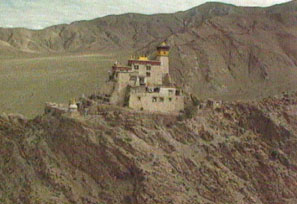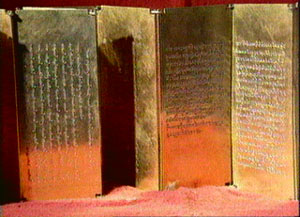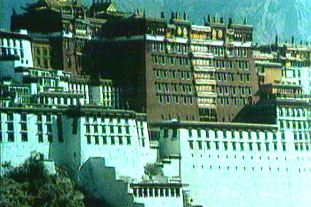 |
|
| Potala Palace |
| CCTV.COM 2002-08-02 14:08:20 |
|
On a mysterious plateau in the southwest of China live the Tibetans who are an ancient nationality. Being centuries-old Buddhist adherents, many of them travel long distances to Potala Palace on the top of Red Mountain in Lhasa, prostrating every step, to pray for blessings for their next life.
 Potala Palace, standing more than 3,700 meters above sea level, covers an area of 360,000 square meters. The 13-story palace, 117 meters high, is 360 meters from east to west and 270 meters from south to north. It is the highest architectural complex in the world, which includes palaces, castles and a temple. Legend has it that King Songtsan Gambo of Tubo was a Buddhist adherent who often chanted Buddhist sutras on a mountain near Lhasa after he had his capital moved there. Later he named the mountain Potala. In 641, he married Tang-dynasty Princess Wencheng and built a palace on the mountain for her. Of the original palace, only the main hall and the Hall of King of Dharma are still extant. The present Potala Palace was reconstructed in the 17th century. Potala Palace, standing more than 3,700 meters above sea level, covers an area of 360,000 square meters. The 13-story palace, 117 meters high, is 360 meters from east to west and 270 meters from south to north. It is the highest architectural complex in the world, which includes palaces, castles and a temple. Legend has it that King Songtsan Gambo of Tubo was a Buddhist adherent who often chanted Buddhist sutras on a mountain near Lhasa after he had his capital moved there. Later he named the mountain Potala. In 641, he married Tang-dynasty Princess Wencheng and built a palace on the mountain for her. Of the original palace, only the main hall and the Hall of King of Dharma are still extant. The present Potala Palace was reconstructed in the 17th century.
The palace is divided into two parts. The White Palace is Dalai Lama's living quarters and where he conducted political activities. The Red Palace houses stupas of the Dalai Lamas and many Buddhist halls. The red and the white colors embody the former social characteristic of Tibet of combining politics with religion. Dalai Lamas down the ages have lived and conducted religious activities in Potala Palace, which has thus become a sacred place for lamas and Buddhists.
 The Potala Palace preserves a wealth of historical relics and handicrafts. It is a museum of Tibetan history and art. Most precious among them are the large numbers of brightly colored murals. They are divided into four categories: religious stories, customs and habits, biographies, and stories about Princess Wencheng arriving in Tibet which reflect the good relationship of the Han and Tibetan nationalities in the 7th century. On a wall in the western hall is a mural portraying Emperor Shunzhi giving an audience to the 5th Dalai Lama in 1652. The palace also houses a thousand pagodas, 10,000 statues. Its collection also includes gold books, gold and jade seals and imperial mandates--evidences of the relation between the Tibetan local government and the central government of the Ming and Qing dynasties. They also bear witness to China being a unified country with many nationalities. The Potala Palace preserves a wealth of historical relics and handicrafts. It is a museum of Tibetan history and art. Most precious among them are the large numbers of brightly colored murals. They are divided into four categories: religious stories, customs and habits, biographies, and stories about Princess Wencheng arriving in Tibet which reflect the good relationship of the Han and Tibetan nationalities in the 7th century. On a wall in the western hall is a mural portraying Emperor Shunzhi giving an audience to the 5th Dalai Lama in 1652. The palace also houses a thousand pagodas, 10,000 statues. Its collection also includes gold books, gold and jade seals and imperial mandates--evidences of the relation between the Tibetan local government and the central government of the Ming and Qing dynasties. They also bear witness to China being a unified country with many nationalities.
 After Tibet was liberated peacefully in l951, the central government attached great importance to the protection of Potala Palace and allocated a large fund to renovate Potala Palace, the biggest investment on the preservation of an ancient architecture since the establishment of the People Republic of China. Today, the Potala Palace remains a sacred place in the hearts of the Tibetan people. It is also a precious cultural legacy of mankind. After Tibet was liberated peacefully in l951, the central government attached great importance to the protection of Potala Palace and allocated a large fund to renovate Potala Palace, the biggest investment on the preservation of an ancient architecture since the establishment of the People Republic of China. Today, the Potala Palace remains a sacred place in the hearts of the Tibetan people. It is also a precious cultural legacy of mankind.
|
|
Editor: Liu Baoyin CCTV.com
|
|
|
|
|
|
 |









